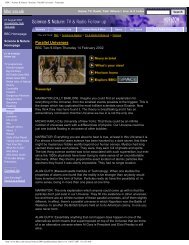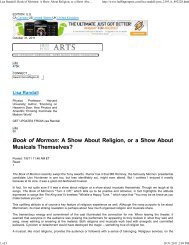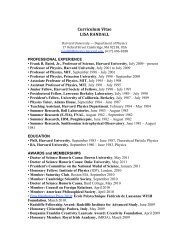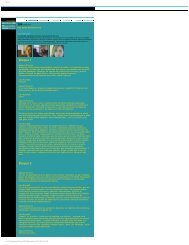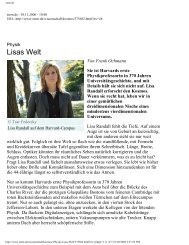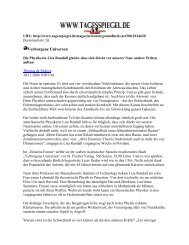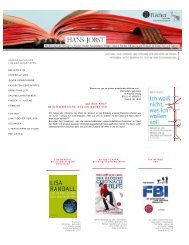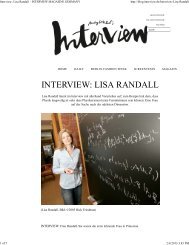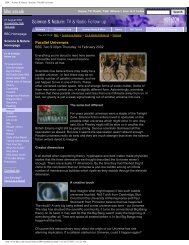Knocking on Heaven's Door, By Lisa Randall
Knocking on Heaven's Door, By Lisa Randall
Knocking on Heaven's Door, By Lisa Randall
- No tags were found...
Create successful ePaper yourself
Turn your PDF publications into a flip-book with our unique Google optimized e-Paper software.
<str<strong>on</strong>g>Knocking</str<strong>on</strong>g> <strong>on</strong> <strong>Heaven's</strong> <strong>Door</strong>, <strong>By</strong> <strong>Lisa</strong> <strong>Randall</strong>Reviewed by Manjit KumarFriday, 16 September 2011Why do things weigh what they do? It seems like a simple enough questi<strong>on</strong>, but physicists d<strong>on</strong>'t know for surewhy particles weigh anything at all. For the best part of 50 years they have had an answer – the Higgs bos<strong>on</strong>. Itplays such a fundamental role in nature that its been dubbed the "God Particle".Attempting to answer the questi<strong>on</strong> of how the universe got its mass means searching for the Higgs bos<strong>on</strong>.It's a nine billi<strong>on</strong>-dollar enterprise involving thousands of scientists and the largest, most complex machineever built. The Large Hadr<strong>on</strong> Collider (LHC) c<strong>on</strong>tains an enormous 26.6km circular tunnel that stretchesbetween the Jura Mountains and Lake Geneva across the French-Swiss border. Electric fields insideaccelerate two beams of prot<strong>on</strong>s as they go around 11,000 times per sec<strong>on</strong>d.In this fascinating book, <strong>Lisa</strong> <strong>Randall</strong>, professor of theoretical physics at Harvard, explains the experimentalresearch at the LHC and the theories that try to anticipate what they will find: "The goal... is to probe thestructure of matter at distances never before measured and at energies higher than have ever beenexplored."These energies should generate an array of exotic fundamental particles and reveal interacti<strong>on</strong>s thatoccurred early in the universe's evoluti<strong>on</strong>, roughly a trilli<strong>on</strong>th of a sec<strong>on</strong>d after the Big Bang, 13.75 billi<strong>on</strong>years ago. In the debris of colliding prot<strong>on</strong>s, physicists hope to find the Higgs bos<strong>on</strong> and get a glimpse atthe nature of dark energy and dark matter that make up 96 percent of the universe.It was 1964 when Peter Higgs c<strong>on</strong>ceived of an invisible field that filled the cosmos immediately after theBig Bang. As the newborn universe expanded and cooled, the field switched <strong>on</strong>. At that moment masslessparticles that had been travelling at the speed of light were caught in the field and became massive. Themore str<strong>on</strong>gly they felt the effects of the field, the more massive they became. Without this field atoms,molecules, galaxies, stars and the planets would not exist.
The Higgs field is like a field of snow that stretches forever in all directi<strong>on</strong>s. Beams of light move as thoughthey have skis <strong>on</strong>: they zip through the field as if it weren't there. Some particles have snowshoes whileothers go barefoot and trudge around. A particle's mass is simply a measure of how much it gets boggeddown in the field.The ripples in the Higgs field appear as particles called Higgs bos<strong>on</strong>s – the snowflakes that make up thecosmic snowfield, and the thing that physicists need in order to explain why stuff weighs anything. TheHiggs mechanism tells how elementary particles go from having zero mass in the absence of the Higgs fieldto having the masses measured in experiments. The Higgs bos<strong>on</strong> is a crucial part of what's called theStandard Model of particle physics. It's a c<strong>on</strong>structi<strong>on</strong> made out of 24 fundamental building-blocks ofmatter: 18 of these particles are six types of quarks that come in three varieties. The remaining six arecalled "lept<strong>on</strong>s", a family that includes electr<strong>on</strong>s.There are also other particles known as "bos<strong>on</strong>s", resp<strong>on</strong>sible for transmitting forces of nature. Theelectromagnetic force is carried by phot<strong>on</strong>s – the particles of light. Inside atomic nuclei, quarks are stucktogether by the str<strong>on</strong>g force carried by "glu<strong>on</strong>s". The W and Z bos<strong>on</strong>s carry the weak force that isresp<strong>on</strong>sible for radioactive decay. "With these ingredients," explains <strong>Randall</strong>, "physicists have been able tosuccessfully predict the results of all particle physics experiments to date."On 10 September 2008, the world's media gathered near Geneva at CERN, home of the European Centrefor Particle Physics, to watch the LHC being switched <strong>on</strong>. "People followed the trajectory of two spots oflight <strong>on</strong> a computer screen with unbelievable excitement," recalls <strong>Randall</strong>.In the m<strong>on</strong>ths to follow, the LHC was to be cranked up to energies that would replicate those of the earlyuniverse, but nine days later euphoria transformed into despair as a malfuncti<strong>on</strong> triggered an emergencyshutdown. After a year-l<strong>on</strong>g delay and repairs costing $40m, the LHC came back <strong>on</strong>line in November 2009.Yet there are other, even bigger, problems in particle physics that the LHC should help to solve. One is thehierarchy problem. The Higgs mechanism addresses the questi<strong>on</strong> of why fundamental particles have mass.The hierarchy problem asks the questi<strong>on</strong>, why those masses are what they are.Another c<strong>on</strong>cerns hints about the "holy grail of physics", the so-called "theory of everything". The bestcandidate for such a theory is superstrings, in which particles are really little oscillating bits of "string". Thedifferent levels of "vibrati<strong>on</strong>" of these strings corresp<strong>on</strong>d to the different particles. Alas, it was later foundthat there were at least five different string theories. Physicists were relieved when it was discovered theywere all just different approximati<strong>on</strong>s to a more fundamental theory called M-theory. However, the theoryposes enormous c<strong>on</strong>ceptual and mathematical challenges.
The "super" in superstrings refers to something called supersymmetry. The LHC will be used to look for"supersymmetric particles". If found, they would provide the first tangible evidence in support ofsuperstrings and M-theory. The prop<strong>on</strong>ents of superstrings and M-theory justify their creati<strong>on</strong> by pointingto its elegance and beauty.And there's the problem. The "quest for beauty", which elevates aesthetics over empirical evidence in theformulati<strong>on</strong> of a theory, took centre stage in the more esoteric areas of theoretical physics and cosmology,in the absence of experimental data. An appreciati<strong>on</strong> of beauty certainly has a role to play when faced witha blank piece of paper; an appeal to aesthetic criteria is part of the physicists' unshakeable belief in theunderlying simplicity and beauty of nature. It is <strong>on</strong>e of their most powerful guiding principles. Natureshould not be more complicated than it has to be, they tell themselves.It is this belief that motivates the search for a "theory of everything". <strong>Randall</strong> quotes Keats: "Beauty istruth, truth beauty". It can't be denied that "the search for beauty - or at least simplicity - had also led totruth".Yet she finds the assumpti<strong>on</strong> "a little slippery" and readily admits that "although every<strong>on</strong>e would love tobelieve that beauty is at the heart of great scientific theories, and that the truth will always be aestheticallysatisfying, beauty is at least in part a subjective criteri<strong>on</strong>".There is nothing wr<strong>on</strong>g with speculati<strong>on</strong>; it is a necessary and vital part of any science, as a first step. Thedanger of "truth through beauty" in physics, as <strong>Randall</strong> describes it, is that it makes a virtue of necessity.Wherever experimental evidence can be coaxed out of nature, it suffices to corroborate or refute a theoryand serves as the sole arbiter of validity. As Darwin's champi<strong>on</strong> Thomas Huxley <strong>on</strong>ce said, "science isorganized comm<strong>on</strong> sense where many a beautiful theory was killed by an ugly fact".Despite the delay in the LHC, it will be a source of invaluable new data that will provide stringentc<strong>on</strong>straints <strong>on</strong> what phenomena or theories bey<strong>on</strong>d the Standard Model can exist. We maybe <strong>on</strong> the edgeof discovery, but for the moment the Higgs bos<strong>on</strong> remains a hypothetical particle <strong>on</strong> which rests the weightof the universe.Manjit Kumar's 'Quantum' is published by Ic<strong>on</strong> Books






